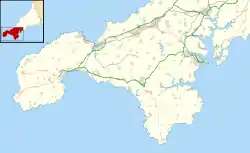Penlee House
Penlee House is a museum and art gallery located in the town of Penzance in Cornwall, and is home to a great many paintings by members of the Newlyn School, including many by Stanhope Forbes, Norman Garstin, Walter Langley and Lamorna Birch. Penlee House is currently operated by Penzance Town Council in association with Cornwall Council. Its most well-known painting is The Rain it Raineth Every Day by Norman Garstin who lived for many years in Wellington Terrace, on the edge of the park.
| Penlee House Gallery and Museum | |
|---|---|
 Penlee House & Cross | |
 | |
| General information | |
| Location | Penzance, Cornwall, England |
| Coordinates | 50°6′59″N 5°32′28″W |
History
Penlee House was originally built in 1865 as the home of the wealthy Branwell family under the directions of John Richards Branwell. The house and gardens were described in The Cornishman newspaper as ″delightful″ and a ″perfect picture″.[1] (Mr Branwell owned the newspaper![2]) On his death in 1902, one of his daughter's, Edith looked after the estate and house, and on her death in 1918 it passed to her elder brother, Alfred. Following Alfred's death in 1939, the property passed to his two daughters, Mrs Vera Hancock and Mrs Sybil Ferguson who sold the house and estate to Penzance Borough Council in 1946. The council purchased Penlee Park as a memorial to the dead of World War II and Penlee House was formally opened as the Penzance District Museum in 1949. In 1974 the ownership of the museum and park passed to Penwith District Council, and since 1985 Penzance Town Council owns and operates the site.[2]
The collections housed within the museum were originally taken from what remained of the Penzance Natural History and Antiquarian Society collection (founded in 1839) which was originally housed within the dome of the Market House in Penzance. During the 1990s Penzance Town Council conducted a major refurbishment of the building providing up to date facilities for housing its important and historic art collection. On the first floor, there are rooms dedicated to the archaeology and social history of the Penwith (Land's End) peninsula.
Penlee Cross
The large granite cross outside the museum dates from the 11th-century and has been moved, on at least three occasions, its original location being the Green Market in Penzance. While this cross was in the Greenmarket it formed the accepted measurement point for the then Borough of Penzance, all settlements within ½ mile of the cross being classified as being within the control of the said Borough and subject to associated local government taxation. It was moved from the Green Market in 1829 a short distance to a house in North Street (Causewayhead) but on the demolition of this house (ca. 1868) the cross was then moved to a position at the western end of the Market House.[3][4]
In July 1899 it was moved to Morrab Gardens and moved again in 1953 to Penlee Park. On 23 September 1997 the cross was erected at its present position by the new entrance to Penlee House. All four sides of the cross can be examined. The height is 2.07 m; width of head 0.685 m; width of shaft at base 0.635 m; width of shaft at neck 0.495 m; thickness 0.265 m[5]
References
- "Mr J R Daniel: one of the Directors of the New Cornish Bank (Limited)". The Cornishman (39). 10 April 1879. p. 4.
- Webb, K C (1995). The Woven Webb – The Branwell Connection. Ballarat: Self published. ISBN 0 646 20374 6.
- Thomas, Charles Penzance Market Cross: a Cornish wonder re-wondered; Penzance: Penlee House Gallery & Museum, 1999
- Langdon, A. G. (1896) Old Cornish Crosses. Truro: Pollard; pp. 308–10
- Langdon, Andrew (1997). Stone Crosses in West Penwith. Federation Of Old Cornwall Societies. pp. 48 & 75. ISBN 0 902660 25 X.
